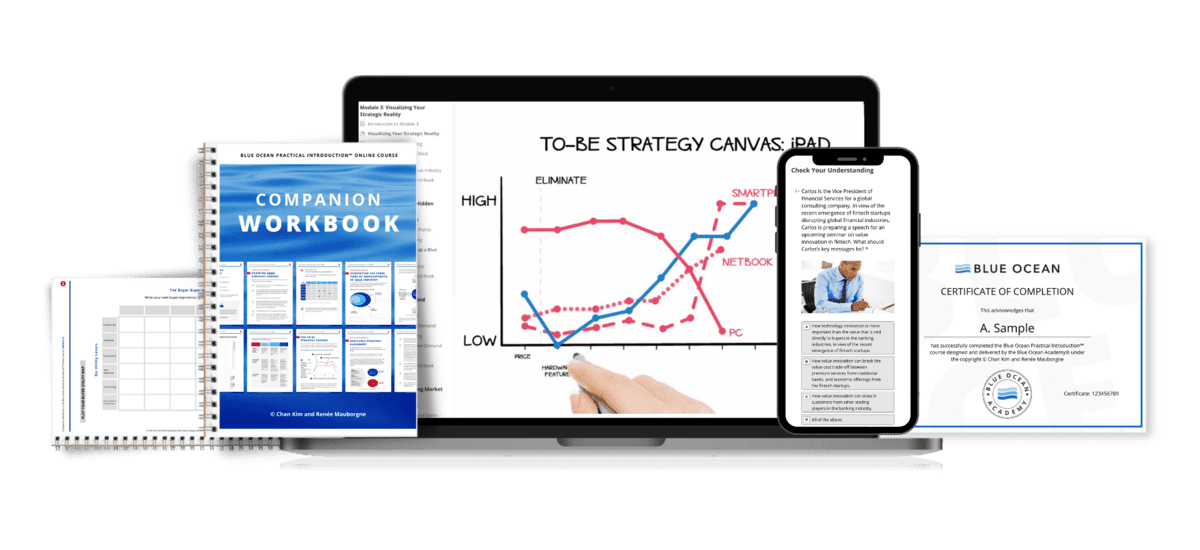THE NYPD
The New York City Police Department (NYPD) executed a blue ocean strategy in the public sector in the 1990s. The NYPD case study illustrates tipping point leadership in action. Tipping point leadership is a key pillar of blue ocean strategy that is central to overcoming organizational hurdles.
When Bill Bratton was appointed police commissioner of New York City in February 1994, the odds were stacked against him to an extent few executives ever face. In the early 1990s, New York City was veering toward anarchy. Murders were at an all-time high. Muggings, Mafia hits, vigilantes, and armed robberies filled the daily headlines.
But Bratton’s budget was frozen. Indeed, after three decades of mounting crime in New York City, many social scientists had concluded that it was impervious to police intervention. With miserable pay, dangerous working conditions, long hours, and little hope of advancement in a tenure promotion system, morale among the NYPD’s thirty-six thousand officers was at rock bottom—not to mention the debilitating effects of budget cuts, dilapidated equipment, and corruption. Few corporate leaders face organizational hurdles as steep as Bratton did in executing a break from the status quo.
Defying conventional wisdom, Bratton achieved breakthrough results in record time with scarce resources while lifting employee morale, creating a win-win for all involved, despite his facing all four hurdles that managers consistently claim limit their ability to execute blue ocean strategy: the cognitive hurdle that blinds employees from seeing that radical change is necessary; the resource hurdle that is endemic in firms; the motivational hurdle that discourages and demoralizes staff; and the political hurdle of internal and external resistance to change. Tipping point leadership reveals how a leader can knock down these hurdles fast and at a low cost by leveraging disproportionate influence factors.
In less than two years and without an increase in his budget, Bill Bratton’s leadership turned New York City into the safest large city in the United States. He broke out of the red ocean with a blue ocean policing strategy that revolutionized U.S. policing as it was then known. Felony crime fell 39 percent, murders 50 percent, and theft 35 percent. Internal surveys showed job satisfaction in the NYPD reaching an all-time high. As one patrolman put it, “We would have marched to hell and back for that guy.” Perhaps most impressively, the changes have outlasted its leader, implying a fundamental shift in the organizational culture and strategy of the NYPD. While the current environmental and political circumstances the NYPD faces differ greatly from then, Bill Bratton was reappointed police commissioner of New York in 2014.
NYPD’s blue ocean strategic move highlights how, by transforming the extremes – the people, acts and activities that exercise a disproportionate influence on performance – tipping point leaders are able to change the core fast and at low cost to execute their new strategy.
THE NYPD
The New York City Police Department (NYPD) executed a blue ocean strategy in the public sector in the 1990s. The NYPD case study illustrates tipping point leadership in action. Tipping point leadership is a key pillar of blue ocean strategy that is central to overcoming organizational hurdles.
When Bill Bratton was appointed police commissioner of New York City in February 1994, the odds were stacked against him to an extent few executives ever face. In the early 1990s, New York City was veering toward anarchy. Murders were at an all-time high. Muggings, Mafia hits, vigilantes, and armed robberies filled the daily headlines.
But Bratton’s budget was frozen. Indeed, after three decades of mounting crime in New York City, many social scientists had concluded that it was impervious to police intervention. With miserable pay, dangerous working conditions, long hours, and little hope of advancement in a tenure promotion system, morale among the NYPD’s thirty-six thousand officers was at rock bottom—not to mention the debilitating effects of budget cuts, dilapidated equipment, and corruption. Few corporate leaders face organizational hurdles as steep as Bratton did in executing a break from the status quo.
Defying conventional wisdom, Bratton achieved breakthrough results in record time with scarce resources while lifting employee morale, creating a win-win for all involved, despite his facing all four hurdles that managers consistently claim limit their ability to execute blue ocean strategy: the cognitive hurdle that blinds employees from seeing that radical change is necessary; the resource hurdle that is endemic in firms; the motivational hurdle that discourages and demoralizes staff; and the political hurdle of internal and external resistance to change. Tipping point leadership reveals how a leader can knock down these hurdles fast and at a low cost by leveraging disproportionate influence factors.
In less than two years and without an increase in his budget, Bill Bratton’s leadership turned New York City into the safest large city in the United States. He broke out of the red ocean with a blue ocean policing strategy that revolutionized U.S. policing as it was then known. Felony crime fell 39 percent, murders 50 percent, and theft 35 percent. Internal surveys showed job satisfaction in the NYPD reaching an all-time high. As one patrolman put it, “We would have marched to hell and back for that guy.” Perhaps most impressively, the changes have outlasted its leader, implying a fundamental shift in the organizational culture and strategy of the NYPD. While the current environmental and political circumstances the NYPD faces differ greatly from then, Bill Bratton was reappointed police commissioner of New York in 2014.
NYPD’s blue ocean strategic move highlights how, by transforming the extremes – the people, acts and activities that exercise a disproportionate influence on performance – tipping point leaders are able to change the core fast and at low cost to execute their new strategy.
THE BLUE OCEAN STRATEGY PRACTITIONER PROGRAM

Transform your strategic perspective, master blue ocean tools and frameworks, & learn to unlock new growth opportunities
Get started with new market creation with our live, interactive, expert-led program.


















